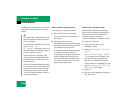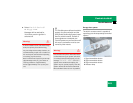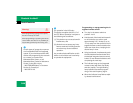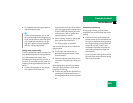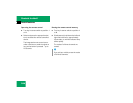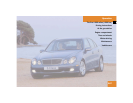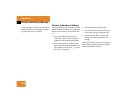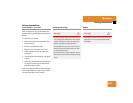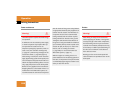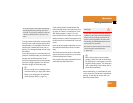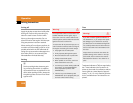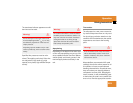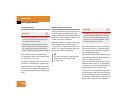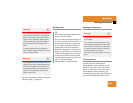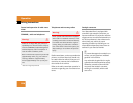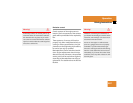
250
Operation
Driving instructions
Power assistance Brakes
Warning! G
The brake system requires electrical energy
for operation.
A malfunction in the vehicle’s power supply
or electrical system may impair brake sys-
tem operation and switch it into its
limp-home (emergency operation) mode. In
such a case, the red brake warning lamp
(
୴ page 291) and warning messages in the
instrument cluster (
୴ page 303) light up
while driving. To brake, the driver must then
apply significantly greater brake pedal pres-
sure and depress the pedal much further to
obtain the expected braking effect. If neces-
sary, apply full pressure to the brake pedal.
Brakes are only applied to the front wheels.
Stopping distance is increased! If there is a
malfunction in the SBC brake system, we
recommend that the vehicle be transported
with all wheels off the ground using flatbed
or appropriate wheel lift/dolly equipment. A
tow bar must be used if circumstances do
not permit the use of the recommended
towing methods and the vehicle requires
towing with all four wheels on the ground.
Towing the vehicle with all four wheels on
the ground is only permissible for distances
up to 30 miles (50 km) and at a speed not to
exceed 30 mph (50 km/h). For more infor-
mation, refer to "Towing the vehicle"
(
୴ page 348). For more information see
SBC brake system (
୴ page 77).
With the engine not running, there is no
power assistance for the steering system. In
this case, it is important to keep in mind that
a considerably higher degree of effort is nec-
essary to steer the vehicle.
Warning! G
After driving in heavy rain for some time
without applying the brakes or through wa-
ter deep enough to wet brake components,
the first braking action may be somewhat
reduced and increased pedal pressure may
be necessary to obtain expected braking ef-
fect. Be sure to maintain a safe distance
from vehicles in front.
Resting your foot on the brake pedal will
cause excessive and premature wear of the
brake pads.



